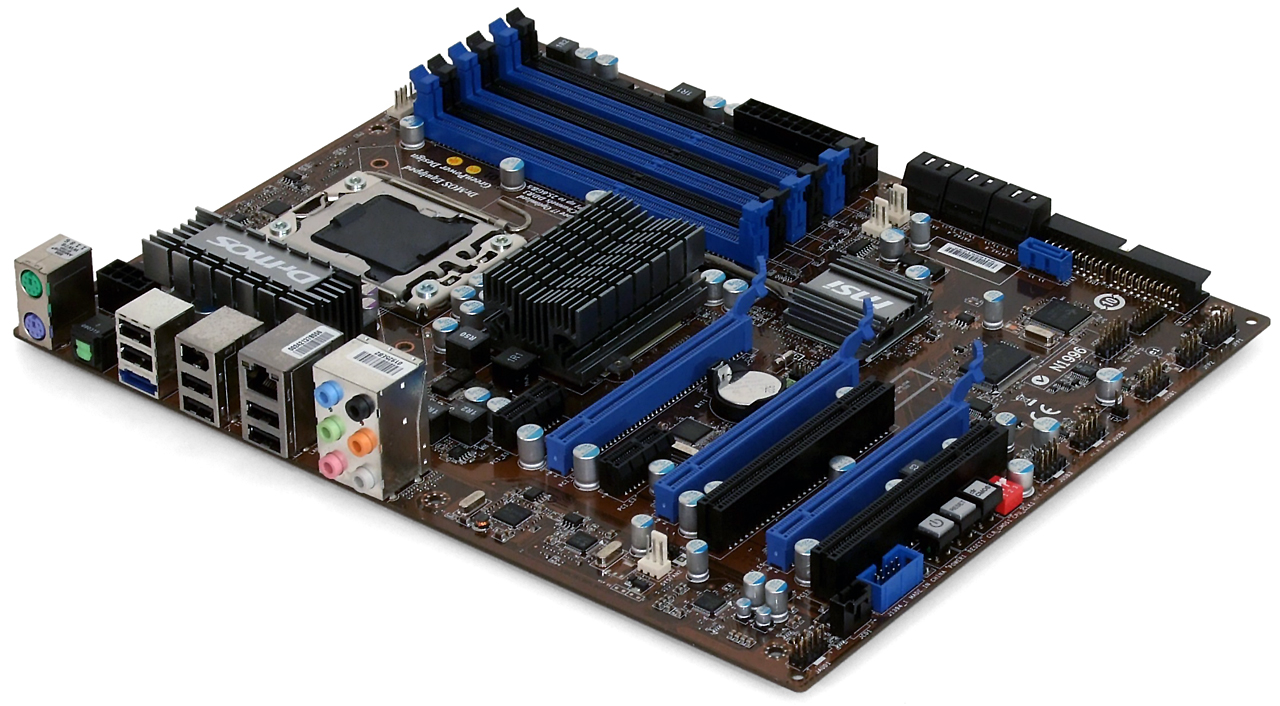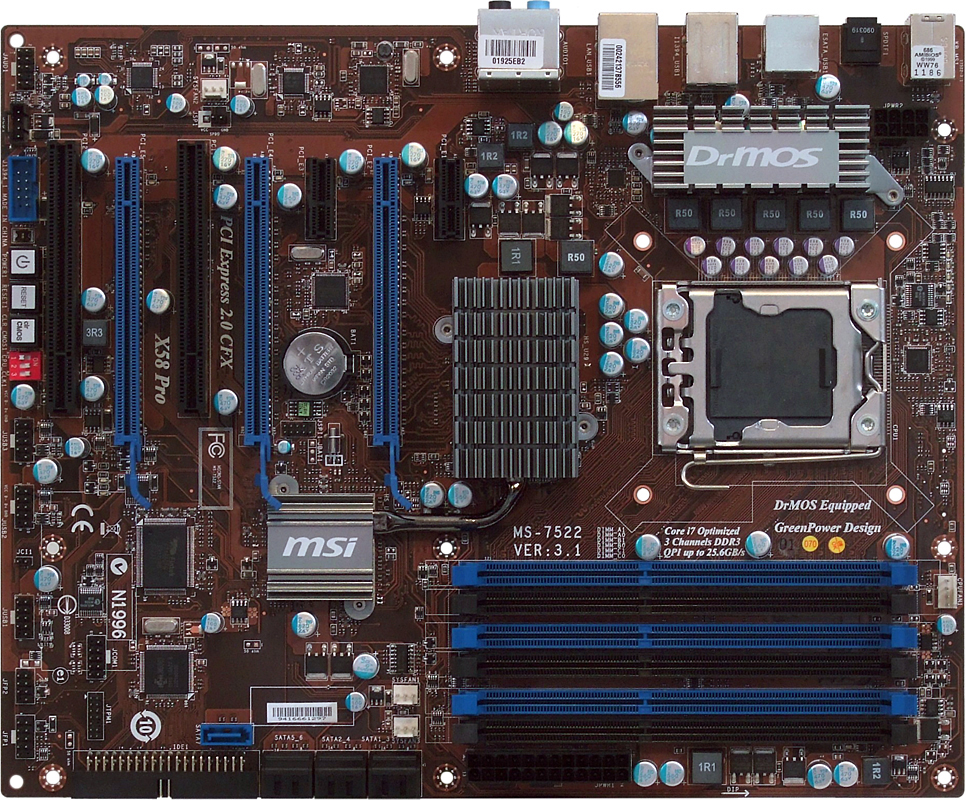X58 On A Budget: Seven Sub-$200 Core i7 Boards
MSI X58 Pro-E
The MSI X58 Pro-E is one of only two motherboards in today’s roundup to properly support seven expansion cards.
Three x16-length PCI Express 2.0 slots support two cards at full bandwidth and a third with x4 pathways. Unlike the similar layout from Asus, MSI spaces its x16 slots as x16-x4-x16, to provide additional airflow when two oversized graphics cards are used in the full-bandwidth slots.
Also similar to Asus is the lack of any Port 80 diagnostics display, which is something we’ve come to expect from enthusiast-oriented products of several smaller-yet-nimbler competitors.
MSI eliminates the “free” floppy interface but keeps the “added price” Ultra ATA controller, even though Windows XP is still more popular in new system builds than are Ultra ATA drives. MSI also does eSATA with a single port on the rear supported through a JMicron JMB363 combination controller, but while Asus lacks any connector for its added internal port, MSI’s can be found directly behind the Ultra ATA header.
The X58 Pro-E places the front-panel-audio connector in the worst possible place (the bottom-rear corner, where the cables of top-panel jacks occasionally won’t reach). MSI also adds a three-switch bus speed manipulation panel, while keeping the BIOS overclocking option. But its offering lacks support for legacy LGA 775 coolers which might be important to some liquid-cooling users.
BIOS
BIOS clock, timing, and voltage ranges can be found on Page 17’s overclocking comparison.
Get Tom's Hardware's best news and in-depth reviews, straight to your inbox.
MSI isn’t known to be a leader in BIOS options, but it’s not going to let its less-expensive product suffer from a lack of controls in such a competitive market. Most of the settings found on its best boards are carried into the lower-cost X58 Pro-E.
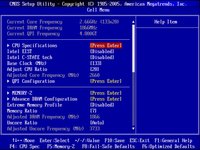
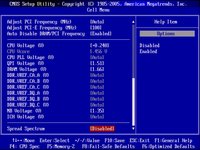
The most important voltage levels, VCore-Uncore-DRAM-IOH, are found along with several others in the X58 Pro-E’s Cell menu. Key frequencies and ratios are also found here.
Memory timing controls appear basic, but several advanced settings can also be adjusted by switching “Advanced Memory Setting” to manual mode.
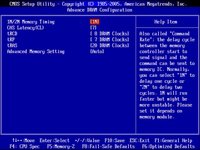
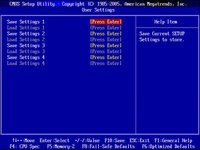
The X58 Pro-E can store up to four custom BIOS profiles, while a separate menu allows flashing and saving BIOS from within the GUI using non-bootable media.
Accessories
MSI uses added documentation to visually improve a very basic installation kit. The X58 Pro-E Specifications page lists SLI support, but no SLI bridge is provided. A CrossFire bridge is provided but usually unneeded, since most CrossFire-capable graphics cards already include one.
-
midnightgun If I am not mistaken, the reason the Asus P6T SE is so cheap is because it does not support SLI, only supports Crossfire. Is that not correct?Reply
-
Crashman Reply9477978 said:If I am not mistaken, the reason the Asus P6T SE is so cheap is because it does not support SLI, only supports Crossfire. Is that not correct?
At the time the review was written, the P6T SE web page read that it supported SLI. Perhaps Asus changed the web page following a complaint?
The big difference between the P6T SE and the P6T is the missing Jmicron SATA multiplier. By removing it, Asus killed the pathway that went to it, leaving the JMB363 controller with a "dead port". -
midnightgun Perhaps. I have had my eye on this board since I started planning my eventual upgrade to i7/i5 architecture (MSI and Gigabyte as well). I know on ncix's forums (canada's equivalent to newegg in the states) the P6T SE had been listed as only crossfire since at least mid May.Reply
-
Crashman midnightgunPerhaps. I have had my eye on this board since I started planning my eventual upgrade to i7/i5 architecture (MSI and Gigabyte as well). I know on ncix's forums (canada's equivalent to newegg in the states) the P6T SE had been listed as only crossfire since at least mid May.Reply
I never trust a seller as a source: Asus listed the P6T SE as having SLI support as little as four weeks ago, and now has a completely different page for it. They weren't the only company that advertised SLI capability and leave out the bridge, but it now appears the former P6T SE web page must have been an error, probably from the company copying its P6T page and editing it for the P6T SE, but missing one detail.
-
anamaniac Personally I will (atleast attempting to now) head straight for the Foxconn Bloodrage with a i7 920 and 3 ddr3 1333 sticks (and give them good timings, ignoring bandwidth and attempting a lower voltage) and a 4870 1gb (due to them being quite cheap now). =DReply
Though first on my priority list is a better monitor (and rent).
Neat article regardless. -
ceteras What an inspiring name for the Foxconn mainboard... looks like it's a corporate culture thing.Reply
I've skipped the Foxconn page, wouldn't buy from them anyway. -
Onus Interesting read. If I were going to build an i7 rig for myself, that ASRock would probably be my choice. I'm not thrilled about the VRM heating up so much, but I only do low-moderate overclocks so it ought to be ok. The feature set of that board looks suitable.Reply -
gxpbecker I am kinda surprised that the ECS board held its own against these "sronger" boards. From my past experieces ECS has been the walmart brand of mobos. :)Reply -
Ryun Question: Is the Asrock board able to go into S3 state/Standby mode? The one board I got from Asrock would not and after emailing their tech support they responded by saying that their boards do not support S3 state.Reply
